The more the merrier
A look back at the 2011 FLW Tour season
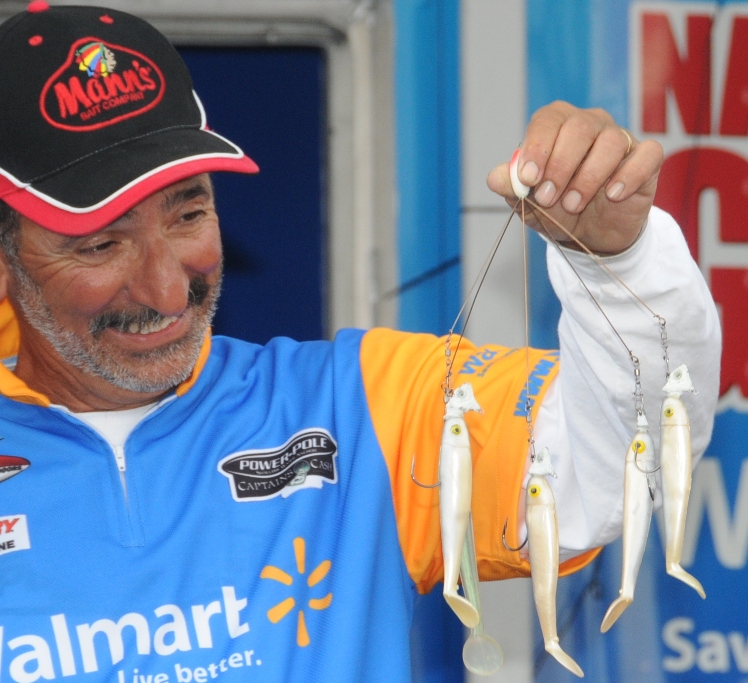
In seven weeks the 2012 Walmart FLW Tour season will kick off on Lake Okeechobee and a brand-new tournament campaign will begin. But before the slate is wiped clean and the first boat number is called for a new beginning, it might be fun to take a brief look back over the 2011 FLW Tour season to revisit some of the highlights, string together some common denominators and see if any deductions can be made about bass fishing in 2012.
Speaking of Lake Okeechobee, that’s a perfect place to start this look back. Last year’s season opener on the Big O destroyed the old FLW Tour record books. Weather, water and lunar conditions lined up perfectly the first week of February to produce a big-fish parade few had ever witnessed in FLW Tour history. The first day of the tournament, 52 pros (one-third of the field) exceeded the 20-pound mark, and 13 of those pros sacked more than 25 pounds. To see pros walk up the bank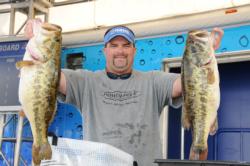 with big limits and hear them say, “No, not too good today, I only have 18 or 19 pounds,” is just surreal.
with big limits and hear them say, “No, not too good today, I only have 18 or 19 pounds,” is just surreal.
Chad Prough took an early lead in the event, catching 35 pounds, 3 ounces on day one and 32 pounds, 4 ounces on day two. And he caught those ginormous limits by sight-fishing. Can you imagine sight-fishing 7- to 10-pound bass for two days in a row?
Brandon McMillan went on to win the event, setting a new FLW Tour four-day weight record of 106 pounds, 10 ounces. Other names that rewrote the books that week with multiple records included Randall Tharp, Terry Scroggins, Fred Roumbanis and Peter Thliveros. In all, consider that 27 new 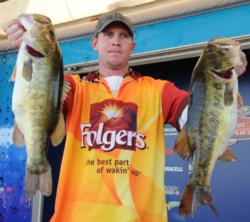 FLW Tour weight records were set from that single event.
FLW Tour weight records were set from that single event.
McMillan’s victory was his first win on the FLW Tour, and with it he sort of kicked off a trend for first-time Tour winners in 2011. First-time winners took home seven of the 10 FLW Tour trophies in 2011. Others notching their first FLW Tour wins included Jason Christie at Lake Hartwell; Clifford Pirch at Lake Chickamauga; John Cox at the Red River; Chad Grigsby at Kentucky Lake; Mark Rose at Pickwick Lake; and Dave Wolak at Lake Champlain.
Of those wins, the most memorable was Tour rookie John Cox of Florida who blasted his 17-foot aluminum boat through an underground culvert to reach a productive pond on the other side. With a mere 16 inches of water flowing out of the pipe, Cox would use a 75-horse outboard to force his way about halfway through the pipe, and then he relied on a two-by-four to literally pry his way, inches at a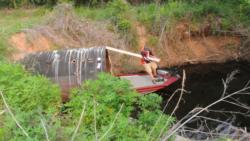 time, through the culvert until he reached the other side. His extreme efforts were rewarded with one of the most unique wins in FLW Tour history.
time, through the culvert until he reached the other side. His extreme efforts were rewarded with one of the most unique wins in FLW Tour history.
Interestingly, there is a new requirement in the 2012 FLW Tour rules that makes the minimum boat length 18 feet (formerly 16 feet) and the minimum horsepower rating at 150.
Seconds, doubles, pairs and deuces
In reviewing the 2011 season, the number two kept coming up. David Dudley won his second FLW Tour Angler of the Year. Dudley’s fishing intuition is uncanny: He has a sixth sense for being at the 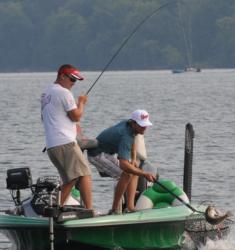 right place at the right time. It’s as if he can pick up the scent of a pattern in the air and turn it into a solid finish everywhere he goes. Out of 11 FLW Tour events this year, Dudley cashed a check in every event and posted six top-20 finishes, four of which were top-10s.
right place at the right time. It’s as if he can pick up the scent of a pattern in the air and turn it into a solid finish everywhere he goes. Out of 11 FLW Tour events this year, Dudley cashed a check in every event and posted six top-20 finishes, four of which were top-10s.
Meanwhile, Brent Ehrler finished second in the AOY race for the second time – and, ironically, both times to Dudley. Ehrler’s string of close calls with the FLW Tour AOY in the last four years is quite amazing as well. He has also finished third and fifth in the FLW Tour points race.
And speaking of second seconds, pro Kevin Snider finished second in the last two FLW Tour events of the season at Kentucky Lake and Pickwick, proving that when ledge fishing is in the mix, he is one to contend with.
EverStart pro Randall Tharp posted a pair of seconds as well, finishing runner-up at Okeechobee and then second at the Forrest Wood Cup.
A couple of co-anglers doubled up with back-to-back FLW Tour wins in 2011. Keeton Blaylock scored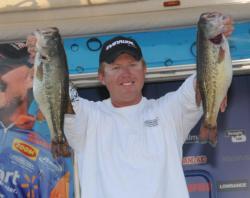 a win at Beaver Lake from the back of the boat and then did it again at Chickamauga. At the end of the season, co-angler Casey Martin won Champlain and Guntersville in back-to-back fashion.
a win at Beaver Lake from the back of the boat and then did it again at Chickamauga. At the end of the season, co-angler Casey Martin won Champlain and Guntersville in back-to-back fashion.
The power of two continued with equipment. Last year saw a marked increase in the number of pros donning two Power-Poles on their boats instead of one. The reason: if one is good, two must be better. Staple your boat down with a pair of Power-Poles in a strong cross-wind and your bow is going to stay put instead of rotating around on a single axis.
That same logic is now starting to find its way to depth finders on the front deck: If one is good, two must be better. Just ask offshore expert Mark Rose, who has been running two Lowrance units in his bow for a few years with impressive results, including his FLW Tour win on Pickwick this year. Rose currently runs two HDS 10s side by side on his bow. He usually dedicates one of the big screens to zoomed-in GPS mapping so he can see his exact boat position relative to any tiny contour changes, and the other unit displays full sonar. But if needed, Rose can also split the screens up into multiple functions so he can watch GPS, sonar, DownScan and StructureScan all at once.
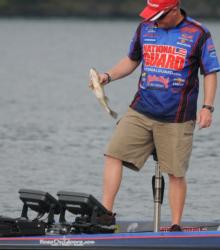 Due to Rose’s offshore success, I’m betting two depth finders on the bow will be more common in 2012.
Due to Rose’s offshore success, I’m betting two depth finders on the bow will be more common in 2012.
Additional electronics may be eating up more front-deck space in the future, but it pales in comparison to the amount of space being consumed by rods on the deck. In 2011 I noticed the number of rods pros have out on the decks during tournaments is at an all-time high. Back in the day, pros made a living with six or seven rods on the deck and a few spares in the locker. Now it’s more common to see 15 on the deck with another 15 stowed away underneath, rigged and ready for action. Even pros considered “specialists” in a particular style of fishing such as flipping or ledge-fishing are rigging more rods within their category.
For instance, some might think that ledge-fishing just requires a couple of crankbaits and a Carolina rig. But check out Mark Rose’s ledge arsenal and you will also find spoons (flutter type and jigging type), football-head jigs, bucktail jigs, shaky heads and swimbaits.
The flippers are not just one-track-minded with a single 1/2-ounce jig anymore either. They rig several different jigs with varying weights, colors and trailers. Then they tie on a couple of soft-plastic creature baits under two or three different-sized weights. They have flipping sticks dedicated to braid and flipping sticks dedicated to fluorocarbon, and some still have flipping sticks dedicated to monofilament. In essence, the two-flipping-stick pro of yesteryear is now an eight-flipping-stick pro of today.
Suspended apprehended
I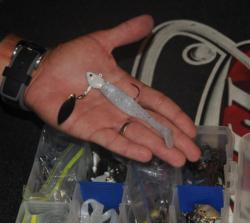 n terms of top lures for 2011, three in particular stand out. First is the MegaBass Vision 110 suspending jerkbait, which dominated the Beaver Lake Tour event. Nine of the top 10 finishers, including winner Bryan Thrift, were using the Vision 110.
n terms of top lures for 2011, three in particular stand out. First is the MegaBass Vision 110 suspending jerkbait, which dominated the Beaver Lake Tour event. Nine of the top 10 finishers, including winner Bryan Thrift, were using the Vision 110.
The second is the Sworming Hornet Fish Head Spin – the lure Scott Martin used to win the Forrest Wood Cup at Lake Ouachita. The Fish Head Spin also played a roll in Kevin Hawk’s Lake Lanier Forrest Wood Cup win in 2010 – that’s two championship wins in a row where the Fish Head Spin has been the key player.
And last, but certainly not least, is the Alabama rig, which, of course, is the bass-fishing story of 2011. The Alabama rig is certainly a revolutionary concept in bass fishing. A castable umbrella rig with multiple baits and hooks is uncharted territory in the world of freshwater black-bass fishing, and, therefore, much more is still to be learned about this technique. As it continues to sweep across the nation, it will be interesting to see how this fishing method will be interpreted by various state resource agencies and where it settles out on the virtues of “fair chase” in fishing.
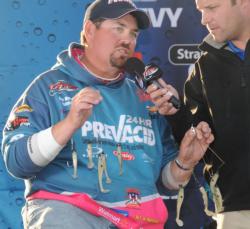 But as for now, the Alabama rig’s potent fish-fooling power is undeniable. In addition to the Lake Guntersville FLW Tour win and the EverStart Championship win on Kentucky Lake, the number of stories I’ve heard about how many fish the Alabama rig catches on water thought to be “used up” or “too pressured” is just unfathomable. This proves, yet again, how a new look, profile or vibration can turn lure-weary bass into piranhas.
But as for now, the Alabama rig’s potent fish-fooling power is undeniable. In addition to the Lake Guntersville FLW Tour win and the EverStart Championship win on Kentucky Lake, the number of stories I’ve heard about how many fish the Alabama rig catches on water thought to be “used up” or “too pressured” is just unfathomable. This proves, yet again, how a new look, profile or vibration can turn lure-weary bass into piranhas.
For the sake of this review, however, what I find particularly interesting about these three standout lures (assuming the Alabama rig is adorned with swimbaits) is they are all shad imitators that target suspended fish.
Offshore schools of suspended bass are essentially the sunken treasure ships of tournament bass fishing. They are hard to locate, hard to keep up with and even harder to trick into biting. But should a pro tap such a school during a tournament, he looks like Mel Fisher unearthing the Atocha, gathering huge margins of loot. Scott Martin’s Forrest Wood Open win and Paul Elias’ win at Guntersville are examples of this.
The common ground found in a Vision 110, a Fish Head Spin and an Alabama rig is the type of fish they 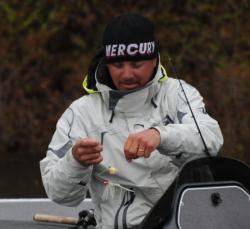 target: mostly suspended fish. And with these better tools, pros are becoming more adept at fooling a class of fish that has long been regarded as the hardest bass to catch, especially on highland lakes. My guess is this trend is only going to continue in the future.
target: mostly suspended fish. And with these better tools, pros are becoming more adept at fooling a class of fish that has long been regarded as the hardest bass to catch, especially on highland lakes. My guess is this trend is only going to continue in the future.
In all fairness, though, that’s not to say that good, old-fashioned bank beating has gone out of style just yet. Jason Christie won the Lake Hartwell Tour event in less than 2 feet of water with a spinnerbait – a real blast from the past. In addition, Jay Yelas went against the ledge-fishing grain at Kentucky Lake in June and finished third by flipping bushes on Lake Barkley with a jig.
So that’s about it for 2011. In sum, all I can say is the “more is better” philosophy seems to have returned to tournament fishing. And I only say that because about five years ago this sport was in an era of “less is more” with weightless Senkos, slinky shaky heads, tiny finesse jigs and diminutive drop-shots. Now it’s two of everything, a pile of rods on the deck and an apparatus that can cast five lures at one time – the more the merrier.